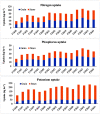Impact of manures and fertilizers on yield and soil properties in a rice-wheat cropping system
- PMID: 37943812
- PMCID: PMC10635533
- DOI: 10.1371/journal.pone.0292602
Impact of manures and fertilizers on yield and soil properties in a rice-wheat cropping system
Abstract
The use of chemical fertilizers under a rice-wheat cropping system (RWCS) has led to the emergence of micronutrient deficiency and decreased crop productivity. Thus, the experiment was conducted with the aim that the use of organic amendments would sustain productivity and improve the soil nutrient status under RWCS. A three-year experiment was conducted with different organic manures i.e. no manure (M0), farmyard manure @ 15 t ha-1 (M1), poultry manure @ 6 t ha-1(M2), press mud @ 15 t ha-1(M3), rice straw compost @ 6 t ha-1(M4) along with different levels of the recommended dose of fertilizer (RDF) i.e. 0% (F1), 75% (F2 and 100% (F3 in a split-plot design with three replications and plot size of 6 m x 1.2 m. Laboratory-based analysis of different soil as well as plant parameters was done using standard methodologies. The use of manures considerably improved the crop yield, macronutrients viz. nitrogen, phosphorus, potassium and micronutrients such as zinc, iron, manganese and copper, uptake in both the crops because of nutrient release from decomposed organic matter. Additionally, the increase in fertilizer dose increased these parameters. The system productivity was maximum recorded under F3M1 (13,052 kg ha-1) and results were statistically identical with F3M2 and F3M3. The significant upsurge of macro and micro-nutrients in soil and its correlation with yield outcomes was also observed through the combined use of manures as well as fertilizers. This study concluded that the use of 100% RDF integrated with organic manures, particularly farmyard manure would be a beneficial resource for increased crop yield, soil nutrient status and system productivity in RWCS in different regions of India.
Copyright: © 2023 Dhaliwal et al. This is an open access article distributed under the terms of the Creative Commons Attribution License, which permits unrestricted use, distribution, and reproduction in any medium, provided the original author and source are credited.
Conflict of interest statement
The authors have declared that no competing interests exist.
Figures





References
-
- Gamage A, Gangahagedara R, Gamage J, Jayasinghe N, Kodikara N, Suraweera P, et al.. Role of organic farming for achieving sustainability in agriculture. Farm Syst. 2023; 1: 100005. doi: 10.1016/j.farsys.2023.100005 - DOI
-
- Biswas DR. Nutrient recycling potential of rock phosphate and waste mica enriched compost on crop productivity and changes in soil fertility under potato–soybean cropping sequence in an Inceptisol of Indo-Gangetic Plains of India. Nutr Cycl Agroecosyst. 2011; 89: 15–30. doi: 10.1007/s10705-010-9372-6 - DOI
-
- Laik R, Kumara BH, Pramanick B, Singh SK. Labile soil organic matter pools are influenced by 45 years of applied farmyard manure and mineral nitrogen in the wheat–pearl millet cropping system in the sub-tropical conditions. Agron. 2021; 11: 2190. doi: 10.3390/agronomy11112190 - DOI
Publication types
MeSH terms
Substances
LinkOut - more resources
Full Text Sources
Research Materials
Miscellaneous

